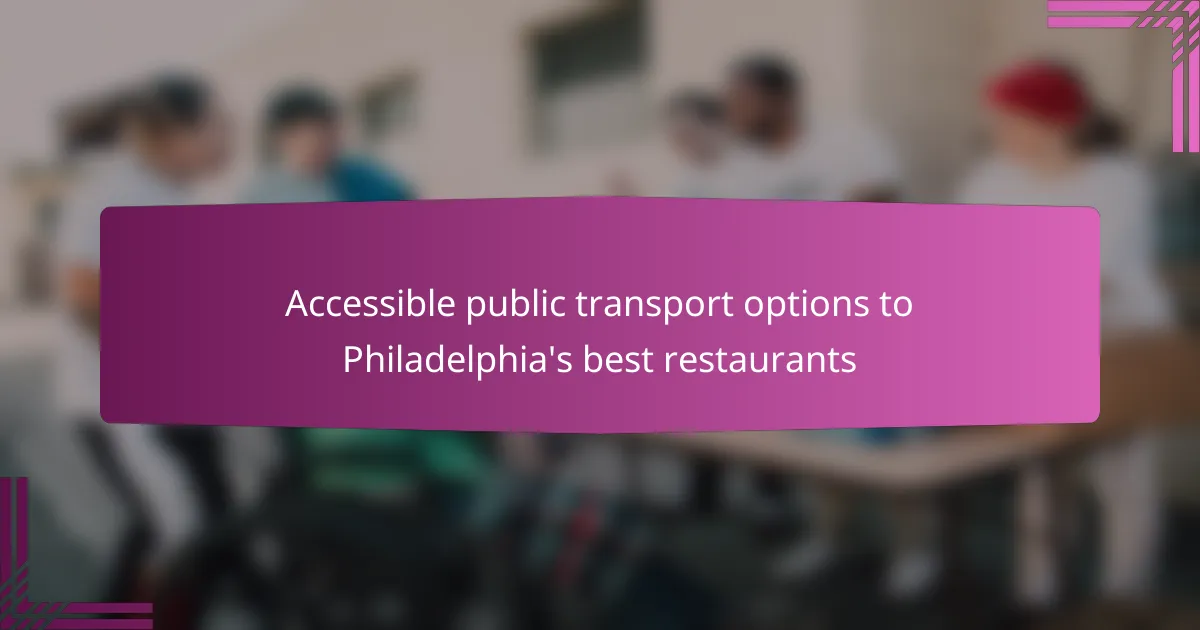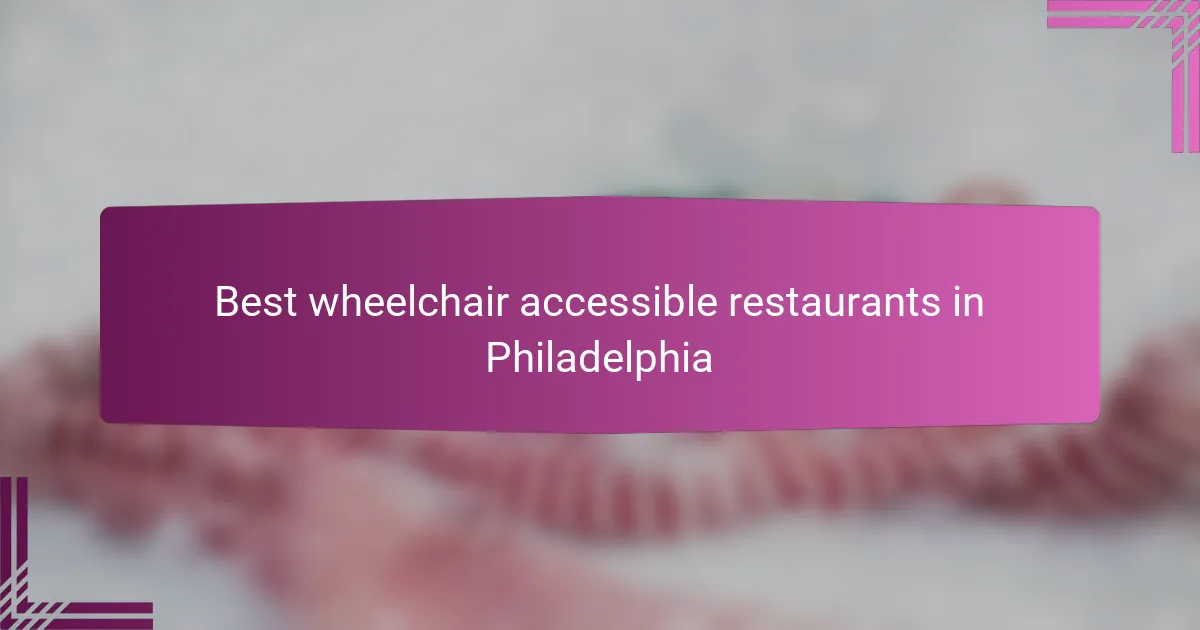
What are the accessible public transport options to Philadelphia’s best restaurants?
Philadelphia’s best restaurants are accessible via several public transport options. The Southeastern Pennsylvania Transportation Authority (SEPTA) operates buses, subways, and trolleys throughout the city. The Market-Frankford Line and Broad Street Line provide direct access to key dining areas. Buses cover neighborhoods not served by rail. Additionally, many restaurants are within walking distance from major transit stops. SEPTA’s website offers route maps and schedules for planning trips. Public transport is affordable and convenient, making it easy to reach popular dining spots.
How do different transport modes cater to accessibility needs?
Different transport modes cater to accessibility needs through various features and adaptations. Buses often include low floors and ramps for wheelchair access. Trains typically have elevators and tactile guidance systems for visually impaired passengers. Taxis may offer services with accessible vehicles upon request. Rideshare companies provide options for wheelchair-accessible vehicles. Public transportation agencies often conduct audits to ensure compliance with accessibility standards. Regulations like the Americans with Disabilities Act mandate these adaptations. These features enhance mobility for individuals with disabilities, ensuring equitable access to transport services.
What features make public transport in Philadelphia accessible?
Public transport in Philadelphia is accessible due to features like low-floor buses and elevators at subway stations. Low-floor buses allow for easy boarding for individuals with mobility challenges. Elevators provide access to underground transit systems, ensuring safe entry and exit. Additionally, audio and visual announcements help passengers with disabilities navigate routes. The Southeastern Pennsylvania Transportation Authority (SEPTA) offers paratransit services for those unable to use standard public transport. These services enhance overall accessibility across the transit network. Compliance with the Americans with Disabilities Act (ADA) further ensures that public transport facilities meet accessibility standards.
How do accessibility features vary among different transport options?
Accessibility features vary significantly among different transport options. Public buses often include low-floor designs and ramps for wheelchair access. Trains typically offer designated seating and accessible restrooms. Taxis may have specific vehicles equipped for accessibility, but availability can vary by city. Rideshare services often provide options for riders needing accessible vehicles. Bicycles and scooters may have limited accessibility features, generally catering to able-bodied users. Each transport mode must comply with local regulations, which can influence the extent of accessibility features provided.
Why is accessibility important for public transport in Philadelphia?
Accessibility is important for public transport in Philadelphia because it ensures that all individuals, including those with disabilities, can utilize transit services. Accessible public transport promotes inclusivity and equal opportunity for all residents and visitors. According to the U.S. Census Bureau, approximately 10% of Philadelphia’s population has a disability. This demographic relies heavily on accessible transportation to reach essential services, including restaurants. Furthermore, the Americans with Disabilities Act mandates that public transport systems provide accessible options. Ensuring accessibility can increase ridership and support local businesses by allowing everyone to access dining options.
What challenges do individuals with disabilities face when using public transport?
Individuals with disabilities face several challenges when using public transport. These challenges include physical accessibility issues, such as the lack of ramps and elevators at stations. Many buses and trains may not have designated spaces for wheelchairs. Additionally, there can be inadequate information regarding schedules and routes in accessible formats. The behavior of staff and other passengers can also pose difficulties, as some may not be trained to assist individuals with disabilities. Furthermore, the design of vehicles may not accommodate all types of disabilities effectively. According to the National Council on Disability, approximately 70% of individuals with disabilities report difficulties accessing public transportation.
How does accessible transport enhance the dining experience in Philadelphia?
Accessible transport enhances the dining experience in Philadelphia by providing convenience and inclusivity. It allows individuals with mobility challenges to reach restaurants easily. Accessible public transport options include buses and trains equipped with ramps and designated seating. This ensures that everyone can enjoy diverse dining options across the city. The availability of accessible transport increases foot traffic to restaurants. It also promotes local businesses by attracting a wider audience. According to the National Transit Database, cities with robust accessible transport systems see higher restaurant patronage. Enhanced accessibility ultimately enriches the culinary landscape of Philadelphia.

What specific public transport options are available in Philadelphia?
The specific public transport options available in Philadelphia include the SEPTA subway, buses, and trolleys. The subway system consists of two main lines: the Market-Frankford Line and the Broad Street Line. SEPTA buses operate extensive routes throughout the city and surrounding areas. Trolleys provide additional service, particularly in the western and southern parts of Philadelphia. Additionally, regional rail services connect the city to nearby suburbs. All these options facilitate access to various destinations, including restaurants. SEPTA’s website provides detailed route maps and schedules for planning trips effectively.
What types of public transport are most commonly used?
The most commonly used types of public transport include buses, subways, and light rail systems. Buses provide extensive coverage in urban areas and are often the primary mode of transport. Subways offer rapid transit options, especially in densely populated cities. Light rail systems serve as a middle ground, providing efficient transport between major areas. According to the American Public Transportation Association, over 9.9 billion trips were taken on public transit in the U.S. in 2019, highlighting the significance of these transport modes.
How do buses accommodate passengers with mobility impairments?
Buses accommodate passengers with mobility impairments through several design features. Many buses are equipped with low floors for easy boarding. Some buses have ramps that can be deployed for wheelchair access. Priority seating is designated for passengers with disabilities. Audio and visual announcements assist in navigation for all passengers. These features comply with the Americans with Disabilities Act (ADA) requirements. The ADA mandates that public transportation must be accessible to individuals with disabilities. Regular training ensures that bus operators assist passengers as needed. These accommodations enhance mobility and access to public transport for all users.
What role do trains play in providing accessible transport options?
Trains serve a crucial role in providing accessible transport options. They connect various neighborhoods and regions efficiently. This connectivity allows individuals, including those with mobility challenges, to reach destinations easily. Many train stations are equipped with ramps and elevators. These features enhance accessibility for passengers with disabilities. According to the American Public Transportation Association, public transit, including trains, reduces travel time significantly. This efficiency encourages more people to use public transport. Trains also offer a reliable alternative to personal vehicles. This can alleviate traffic congestion and reduce carbon emissions.
How do ride-sharing services contribute to accessibility?
Ride-sharing services enhance accessibility by providing on-demand transportation options. They serve individuals who may have limited access to traditional public transport. This includes people with disabilities or those in underserved areas. Ride-sharing apps often feature accessibility options, such as wheelchair-accessible vehicles. According to a study by the National Academies of Sciences, Engineering, and Medicine, ride-sharing can reduce wait times for users. Additionally, these services can improve mobility for those without personal vehicles. In urban settings, ride-sharing complements public transit systems. This integration helps to create a more comprehensive transportation network.
What features do ride-sharing apps offer for users with disabilities?
Ride-sharing apps offer several features specifically designed for users with disabilities. These features include wheelchair-accessible vehicles, which ensure that riders with mobility challenges can use the service. Additionally, many apps provide options to indicate special needs when booking a ride. This allows drivers to prepare accordingly. Some platforms also offer in-app support for users who may require assistance during their ride. Furthermore, ride-sharing services often include driver training focused on accommodating passengers with disabilities. These features aim to enhance accessibility and improve the overall experience for users with disabilities.
How can users access ride-sharing services easily in Philadelphia?
Users can access ride-sharing services easily in Philadelphia through mobile apps like Uber and Lyft. These apps allow users to request rides from their smartphones. Users simply download the app, create an account, and enter their payment information. They can then input their pickup location and destination. The app displays available drivers nearby and provides estimated arrival times. Users can track their driver’s location in real-time. Additionally, ride-sharing services operate throughout the city, making them widely available. Philadelphia’s infrastructure supports these services with designated pickup and drop-off zones.

How can you plan your journey to Philadelphia’s best restaurants using public transport?
To plan your journey to Philadelphia’s best restaurants using public transport, start by identifying the restaurants you want to visit. Use the Southeastern Pennsylvania Transportation Authority (SEPTA) website or app to check routes and schedules. SEPTA provides bus, subway, and trolley services throughout the city. Determine the nearest public transport stop to your location and the restaurant.
Plan your route by selecting the appropriate mode of transport. For example, the Market-Frankford Line subway connects many popular dining areas. Check the frequency of service to minimize wait times.
Consider purchasing a SEPTA Key Card for easy access to all transit options. The Key Card allows tap-and-go entry and can be reloaded. Always verify the latest service updates or changes on the SEPTA website.
Philadelphia’s public transport system is designed to be user-friendly. It offers extensive coverage, making it convenient to reach various dining destinations.
What are the best routes to popular dining destinations?
The best routes to popular dining destinations in Philadelphia include the Market-Frankford Line and the Broad Street Line. The Market-Frankford Line connects the northern and southern parts of the city, making stops near many popular restaurants. Key stops include 69th Street Terminal and 15th Street Station, which are close to dining hotspots.
The Broad Street Line runs north to south, providing access to areas with numerous eateries. Notable stops include City Hall and Walnut-Locust, both near well-known dining options.
Additionally, SEPTA buses and trolleys serve various neighborhoods with excellent restaurants. For example, Route 21 provides access to the Italian Market area, famous for its culinary offerings. The combination of these public transport options ensures convenient access to Philadelphia’s diverse dining scene.
How can you find accessible routes to specific restaurants?
To find accessible routes to specific restaurants, use navigation apps that provide accessibility information. Apps like Google Maps allow users to filter routes based on accessibility features. Check the restaurant’s website for details on accessibility options. Local transit authorities often provide information on accessible public transport routes. Review online resources or forums focused on accessibility for user-shared experiences. Contact the restaurant directly to inquire about accessible entrance and route information. These methods ensure you have the most accurate and helpful data for planning your visit.
What tools and apps can assist in planning an accessible journey?
Tools and apps that assist in planning an accessible journey include Google Maps, Citymapper, and Wheelmap. Google Maps provides wheelchair-accessible route options and real-time transit information. Citymapper offers detailed public transport options, including accessibility features for various modes of transport. Wheelmap allows users to find and rate the accessibility of locations, making it easier to choose accessible restaurants. These tools enhance the journey planning experience for individuals with mobility challenges.
What tips can enhance your experience using public transport to reach restaurants?
Plan your route in advance to ensure efficiency. Use transit apps for real-time updates and schedules. Arrive at the station early to avoid last-minute stress. Choose off-peak hours for less crowded transport. Carry a portable charger to keep devices powered. Wear comfortable shoes for walking to the restaurant. Familiarize yourself with nearby landmarks for easier navigation. Keep small change handy for unexpected transit needs.
How should you prepare for using public transport when dining out?
Plan your route in advance using public transport maps and apps. Check the schedules for buses or trains that service your destination. Ensure you have a valid ticket or transit pass before departure. Allow extra time for potential delays in transit. Dress appropriately for the weather, as you may have to wait outside. Consider the distance from the public transport stop to the restaurant. Make a note of the return transport schedule to avoid being stranded. Familiarize yourself with any accessibility options if needed.
What common issues might arise, and how can you troubleshoot them?
Common issues with accessible public transport in Philadelphia may include vehicle breakdowns, service delays, and insufficient information on accessibility features. To troubleshoot vehicle breakdowns, contact the transport service provider immediately for assistance. For service delays, check real-time updates via transit apps or websites. If information on accessibility features is lacking, directly reach out to transport authorities for clarification. Additionally, using alternative routes may help mitigate delays. Always plan trips during off-peak hours to reduce waiting times.
Accessible public transport options to Philadelphia’s best restaurants include various services provided by the Southeastern Pennsylvania Transportation Authority (SEPTA), such as buses, subways, and trolleys. The article outlines how these transport modes cater to accessibility needs, highlighting features like low-floor buses and elevators at train stations. It emphasizes the importance of accessibility for individuals with disabilities and discusses the challenges they face when using public transport. Additionally, the article provides practical tips for planning journeys to popular dining destinations, ensuring a comprehensive understanding of the accessible transport landscape in Philadelphia.



